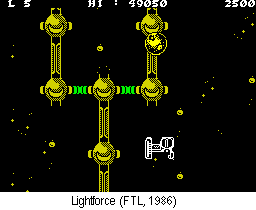|

By Lloyd Mangram
November
1986
Issue 34
|
|
For
me this is probably the least interesting CRASH cover,
and certainly a disappointment from Ian Craig after
the previous month's. The dynamics work well enough
but the definition of both craft and explosion is poor;
it is hard to see where you are or what is happening.
The illustration, of course, relates to FTL's game Lightforce.
|
With the departure of Tony Flanagan there was another shuffle
as Lee Paddon moved over from AMTIX! to CRASH. Lee had joined
Newsfield some months earlier from the magazine Your Computer
to act as the AMTIX! Software Editor - not that there was
a lot of good software to be concerned about. We seemed to
have moved into that strange post-PCW Show period when there
ought to be lots of games released but software houses are
still fighting to get their product completed.
 Gargoyle
Games's new FTL label kicked off well, however, with Lightforce
(right), bemusing everyone with the fact that it was a hard
and fast shoot-'em-up in the Xevious vein rather than
a complex scrolling graphic adventure. 'A chance,' said the
Smash review, for 'mainstream arcade entertainment,' unfortunately
forgetting that that was exactly how Gargoyle Games had started
out three years earlier, with the 3-D shoot-'em-up Ad Astra.
And Lightforce's graphics strongly resembled Ad
Astra. Gargoyle
Games's new FTL label kicked off well, however, with Lightforce
(right), bemusing everyone with the fact that it was a hard
and fast shoot-'em-up in the Xevious vein rather than
a complex scrolling graphic adventure. 'A chance,' said the
Smash review, for 'mainstream arcade entertainment,' unfortunately
forgetting that that was exactly how Gargoyle Games had started
out three years earlier, with the 3-D shoot-'em-up Ad Astra.
And Lightforce's graphics strongly resembled Ad
Astra.
Quicksilva's Glider Rider was an odd case; the 48K
version of this 3-D forced-perspective road game got 80%,
but the 128K version soared to 92%. The real difference seemed
to be the sound. And sound was only one of the problems faced
by Digital Integration's TT Racer. It lost favour for
being too much of a simulation and being too difficult to
play.
But there were two more Smashes. Napoleon At War from
CCS excited Sean Masterson, and the game with the silliest
name ever - Fat Worm Blows A Sparky - earned Durell
some extravagant praise for the 'stunningly original' solid
3-D graphics and its wormy animation.
There were enough disappointments for several issues, mostly
in the budget range, where there was hardly anything of quality
(apart from a few games on Mastertronic's M.A.D. label). Following
on from the previous month's release of Knight Rider
came another Ocean game 18 months late - Street Hawk.
Again the difficulties of developing the game shone through,
though it did slightly better with 68%. Another tie-in proved
a letdown: Asterix And The Magic Cauldron from Melbourne
House. Heavily pushed as their big Christmas game, it was
so bug-ridden that playability was irrelevant. The big arcade
conversion was Dragon's Lair, but Software Projects's
problem in reproducing anything of the original's video-disk
graphics - largely regarded as the only really interesting
element of the arcade machine - let it down dismally on the
Spectrum.
Gremlin Graphics fared far better with their Spectrum version
of the Commodore 64 hit Trailblazer and it was a creditable
and addictive game which just missed being a Smash at 88%.
We featured an interview with programmer Don Priestley, a
man with possibly the longest Spectrum track record; but from
a historical point of view it was the interviewer rather than
the interviewee who was noteworthy. Bill Scolding had been
the editor of Sinclair User and taken that magazine from a
strong position to the leading place till CRASH overtook its
sales. Bill never seemed to have borne CRASH any hard feelings
over the previous year's verbal war - so when he resigned
from Sinclair User earlier in 1986 he had come to Ludlow to
help out for a few weeks with editorial, leading to his ex-colleagues
ringing him at home with a cheery 'Morning Judas'. Sticks
and stones etc . . .
|